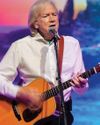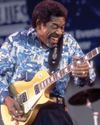
GT: What is it about guitar instrumentals that particularly appeals to you?
BG: I love hearing catchy melodies during guitar instrumentals. If a guitar can bring out the sound of emotion with volume and tone changes, the guitar can speak through the player’s hands. No two players are alike.
GT: What can an instrumental provide a listener that a vocal song can't?
BG: This gives the listener a chance to drift with a player’s notes and feel. Whereas vocal lyrics tell their own story, guitar melodies are open to interpretation. A bluesy slow tasty solo has more impact than fast riffage and tells its own story, and usually, you walk away humming that melody.
GT: Any tendencies with instrumentals that you aim to embrace or avoid?
BG: Overplaying and adding too many parts can be an easy mistake. Heavily distorting rhythm tones can muffle up your song too. I like to take my rhythm parts and double them then pan left and right. Maybe changing to a clean tone and a different guitar for a background part or bridge section works well too. I personally work with a singing sustaining guitar tone for soloing but there are a few ballad songs on the new Night Ranger record. I used my 1957 Stratocaster through different old Fender Blackface amps and worked my volume control for different guitar shades.
GT: Is a typical song structure intro, verse, chorus, middle, etc, always relevant for the dynamics of an instrumental?
This story is from the {{IssueName}} edition of {{MagazineName}}.
Start your 7-day Magzter GOLD free trial to access thousands of curated premium stories, and 9,000+ magazines and newspapers.
Already a subscriber ? Sign In
This story is from the {{IssueName}} edition of {{MagazineName}}.
Start your 7-day Magzter GOLD free trial to access thousands of curated premium stories, and 9,000+ magazines and newspapers.
Already a subscriber? Sign In

THE MOODY BLUES
This month Stuart Ryan delves into the picking style of this British prog legend whose acoustic guitar has powered many a Moody Blues song.

WAYNE KRANTZ
This issue Nick Mellor provides an insight into this brilliant jazz stylist, focusing on his approach to improvising over static chords.

OPEN G TUNING
Open tunings are great fun and can help create exciting new ideas. Simon Barnard shows how to incorporate open G tuning into your playing.

RODRIGO GOUVEIA
Last month we featured Mateus Asato, and mentioned the importance of the neo-soul style in his playing. Here we turn to his fellow Brazilian, the master of neo-soul fusion.

MARK KNOPFLER
Our topic this month is a master craftsman as both guitar player and songwriter. His style is unique and his influence spreads far and wide.

U2
Martin Cooper checks out the chiming pedal delay tones of this stadium-filling band from Dublin, Ireland, and guitarist The Edge.

LUTHER ALLISON
It’s blues with a touch of soul this month, as David Gerrish explores the dynamic, expressive style of an often overlooked Chicago bluesman.

JOHANN KASPAR MERTZ Capriccio
This month Declan Zapala explores the music of Austria at the turn of the Romantic period with a fiery caprice to level up your fingers and unlock your inner virtuoso.

THE CROSSROADS Michael Landau
John Wheatcroft explores the playing of a session ace _ and blazing blues-rock maestro who graces the top-flight m band of singer-songwriting legend, James Taylor.

VIDEO MASTERCLASS Troy Redfern
This month GT welcomes this slide guitar virtuoso. If you've been wanting to take your slide playing to the next level then this is one's for you. With Jon Bishop.